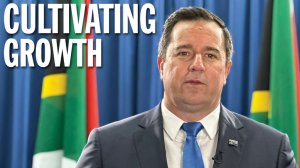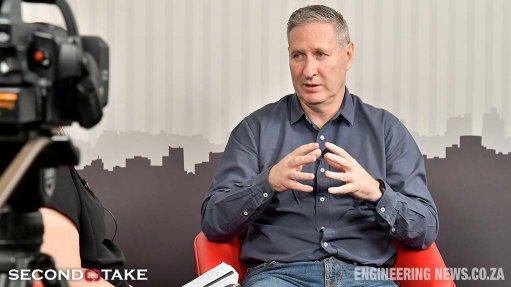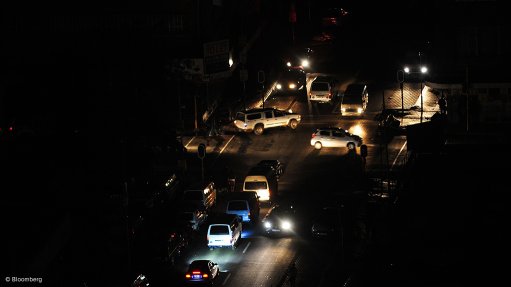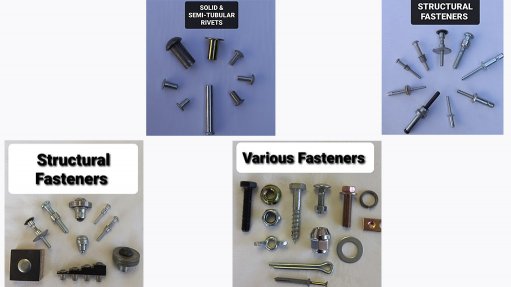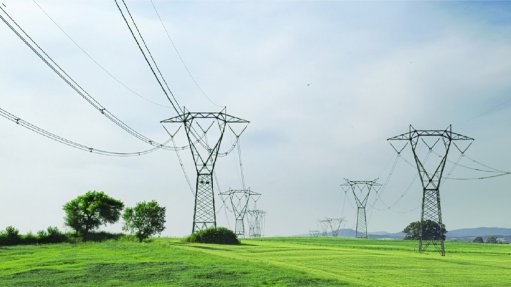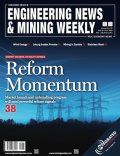Steenhuisen outlines vision for growing and modernising SA’s agriculture ecosystem

Agriculture Minister John Steenhuisen unpacks major growth constraints in the industry and how he plans to modernise the sector
Newly appointed Agriculture Minister John Steenhuisen is pushing a renewed focus on structural reforms, biosecurity and improved trade relations with other countries as the Democratic Alliance leader takes charge of the department as part of the Government of National Unity (GNU).
In an exclusive interview with Engineering News & Mining Weekly, Steenhuisen highlights that other prioritised areas are more road-to-rail shifts in agricultural logistics, and the more widespread adoption of technology to reduce crime and increase productivity.
Some agri-economists are optimistic that he will be able to advance the prospects of the industry, a mainstay of growth for the South African economy, having grown by 13.4% and created 21 000 new jobs in the first quarter of this year. Since 2008, its growth rate has averaged 7.5% a year.
Industry bodies, such as the Agricultural Business Chamber of South Africa (Agbiz) and Agri SA, welcomed Steenhuisen’s appointment in July and his subsequent maiden Budget vote, which the organisations say is focused on valuable interventions and relentless implementation.
Agri SA said a noteworthy aspect of the budget was the allocation of R1.7-billion to support more than 6 000 small-scale farmers.
The Minister says there is no need to “reinvent the wheel” and will therefore focus on driving the implementation of the Agriculture and Agroprocessing Master Plan (AAMP), which he deems a solid framework on which inclusive growth in the sector can be based.
Steenhuisen emphasises the importance of blended finance to reduce barriers for small-scale farmers, as well as access to markets. There are also “massive” opportunities for small-scale produce to be procured by hospitals, schools and prisons to improve food security in the country.
In the spirit of modernising the sector, he highlights the importance of strong partnerships between sectoral bodies and departments to foster a more efficient and effective regulatory environment.
Some of the legislation governing the agriculture sector dates back to 1947, but “the world has moved on” and Steenhuisen wants to ensure that legislation aligns with newer products and technologies.
The AAMP will be reviewed on a continuous basis to determine which aspects have been working and which ones have not, and where improvement is required, he adds.
The Minister says the plan will evolve over time in a way that ensures the achievement of its objectives, including bigger value chains, more opportunities for small- and large-scale farmers, better biosecurity and expanding export markets.
Steenhuisen cites beef exports to the EU as an example, which he deems “a huge opportunity” for growth and foreign earnings, particularly if South Africa can demand higher prices on the back of high levels of biosecurity.
Other concerns in the agriculture sector involve logistics – “a key problem” – with road transport not only being costly but also resulting in goods being damaged because of potholes, or rural areas not having access to main roads at all, he explains.
Steenhuisen is confident that efforts by the GNU to facilitate more private-sector participation in the rail industry bode well for agriculture and its transport system, with his department ready to collaborate with other government bodies to improve agriculture corridors and ports in the country.
Another crucial area of collaboration will be addressing the high crime rate, which the Minister says disproportionally affects people in rural areas, where most farming activities take place.
Steenhuisen attributes the high crime rate to a lack of effective policing and implementation of a rural safety plan: “Technology [is enabling] farmers to patrol large areas to not only deal with farm attacks but also stock theft. Farmers are implementing sniper cameras . . . to identify number plates and better track down people who have been in and out of certain areas – which can be a deterrent for criminals.”
He adds that, with technology “farmers do not necessarily need more feet on the ground” because they can direct resources in a much more focused way.
Foreign Relations
Steenhuisen says South Africa’s goods have been unfairly prevented from reaching markets in a meaningful way, referring to the recent trade conflicts with neighbouring countries in the Southern African Development Community (SADC) and the EU.
He lauds South Africa’s quality produce and livestock, which he deems beneficial for markets such as those of the EU and the SADC.
On the EU citrus matter – which involves excessively stringent phytosanitary measures on citrus products – Steenhuisen says his department has provided scientific evidence for South Africa’s case to succeed and the Minister looks forward to a fair arbitration and normalisation of trade.
On the regional front, trade tensions involving South African produce in Botswana might have been exacerbated by the looming election in Botswana, which typically sees a rise in protectionist policies. The Minister describes this approach as “penny wise and pound foolish”, since a ban on South African produce drives up the prices of goods in Botswana, and threatens food security.
The Minister hopes to see a mutually beneficial solution arise from engagements between the Department of Trade, Industry and Competition, and Botswana authorities over trade bans, as well as more constructive engagements in the SADC region going forward.
At a Ministerial meeting of the Group of Twenty (G20) Task Force in Brazil, in July, Steenhuisen said current global crises had widened investment gaps in African agriculture, thereby leaving small-scale farmers behind in the development trajectory.
He proposed that the G20 and its partners invest in processes that could unlock local food production opportunities, especially for agroprocessing at local level. This included linking fresh produce markets and informal sector players, family farmers and women- and youth-owned farmers, to create a safer and more diverse set of foods while stimulating production.
The Minister also emphasised the importance of prioritising programmes and evidence-based policy instruments that targeted the countries and populations most affected by hunger and extreme poverty.
“I cannot overemphasise . . . the importance of streamlining our efforts as G20 member States. Implementation. . . should not be done in silos or in separate sectors, as this would not unlock the intended result of food security for all,” Steenhuisen said.
Inner Workings
In terms of more collaboration between his department and provincial and local government entities, Steenhuisen says most of government’s implementation work is through the provinces, with his department having had fruitful meetings with MECs in recent weeks to grow the sector in every province.
He also emphasises the importance of working with municipalities – on aspects such as sewerage reticulation – since improper pump systems lead to polluted irrigation schemes and affect crop health.
Steenhuisen cites his department’s often working with the Department of Cooperative Governance and Tradition Affairs on such matters, as well as natural disaster management, since farmers often grapple with fires and floods.
Commenting on the unfolding split between the departments of Agriculture, and Land Reform and Rural Development (following another recent split of the Department of Agriculture, Forestry and Fisheries), the Minister says it will be a “positive split”, with more dedicated focus on key priorities for both agriculture and land reform.
However, he adds that the Ministries will still be working hand-in-hand to ensure there are synergies in their approaches to the agriculture sector and to land reform.
Further, on advancing technology in the sector and his department’s collaboration with private-sector entities, Steenhuisen says a large portion of the expertise, knowledge and experience in the industry is in sectoral organisations and academic institutions.
By leveraging partnerships with organisations such as Agbiz, more potential can be unlocked; for example, regarding biosecurity and the transportation of livestock in the country to successfully manage disease outbreaks.
Importantly, the work started under former Agriculture Minister Thoko Didiza will continue, particularly the work of a Ministerial Special Task Team to provide insight on ways of improving animal health in South Africa.
Industry bodies, including Agri SA, have also called for more accountability in grant allocation, improved extension services, modernised legislation and more interdepartmental collaboration. It remains concerned about the misallocation of funds intended for farmers, but acknowledges Steenhuisen’s Budget vote that clarified the need for better planning, accountability and proper reporting against targets.
Agri SA’s stance is that effective agriculture development relies on robust infrastructure, including roads, railways and ports, which fall under various departments. The organisation believes that improved collaboration with, and between, these departments is crucial to support the agriculture sector adequately and unlock its full potential.
Comments
Press Office
Announcements
What's On
Subscribe to improve your user experience...
Option 1 (equivalent of R125 a month):
Receive a weekly copy of Creamer Media's Engineering News & Mining Weekly magazine
(print copy for those in South Africa and e-magazine for those outside of South Africa)
Receive daily email newsletters
Access to full search results
Access archive of magazine back copies
Access to Projects in Progress
Access to ONE Research Report of your choice in PDF format
Option 2 (equivalent of R375 a month):
All benefits from Option 1
PLUS
Access to Creamer Media's Research Channel Africa for ALL Research Reports, in PDF format, on various industrial and mining sectors
including Electricity; Water; Energy Transition; Hydrogen; Roads, Rail and Ports; Coal; Gold; Platinum; Battery Metals; etc.
Already a subscriber?
Forgotten your password?
Receive weekly copy of Creamer Media's Engineering News & Mining Weekly magazine (print copy for those in South Africa and e-magazine for those outside of South Africa)
➕
Recieve daily email newsletters
➕
Access to full search results
➕
Access archive of magazine back copies
➕
Access to Projects in Progress
➕
Access to ONE Research Report of your choice in PDF format
RESEARCH CHANNEL AFRICA
R4500 (equivalent of R375 a month)
SUBSCRIBEAll benefits from Option 1
➕
Access to Creamer Media's Research Channel Africa for ALL Research Reports on various industrial and mining sectors, in PDF format, including on:
Electricity
➕
Water
➕
Energy Transition
➕
Hydrogen
➕
Roads, Rail and Ports
➕
Coal
➕
Gold
➕
Platinum
➕
Battery Metals
➕
etc.
Receive all benefits from Option 1 or Option 2 delivered to numerous people at your company
➕
Multiple User names and Passwords for simultaneous log-ins
➕
Intranet integration access to all in your organisation


